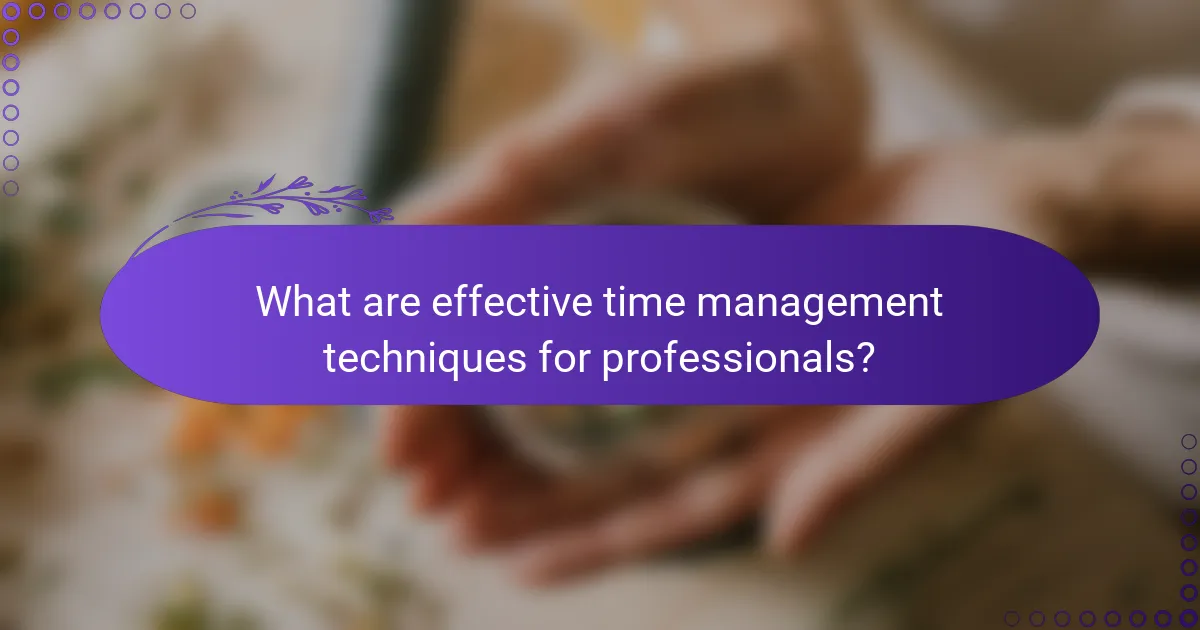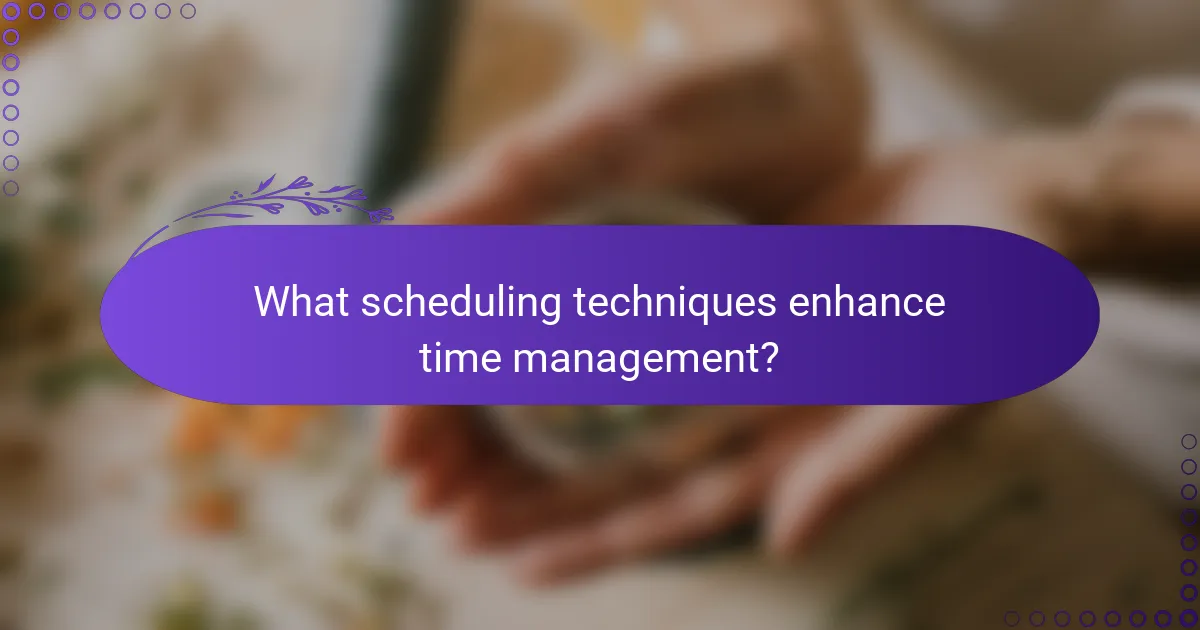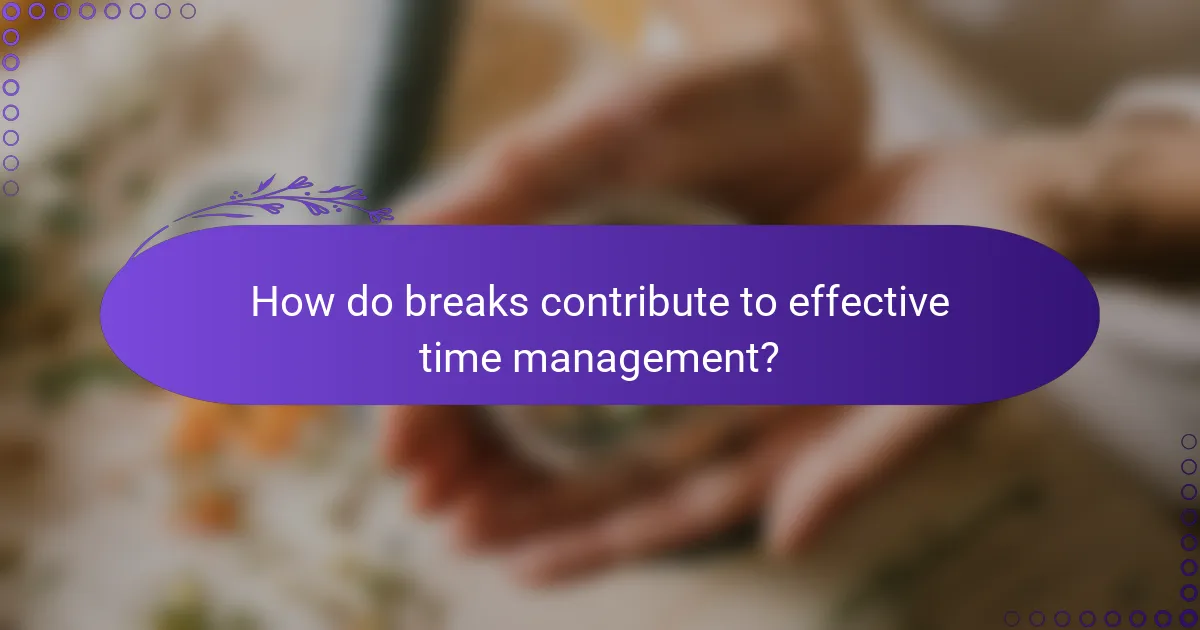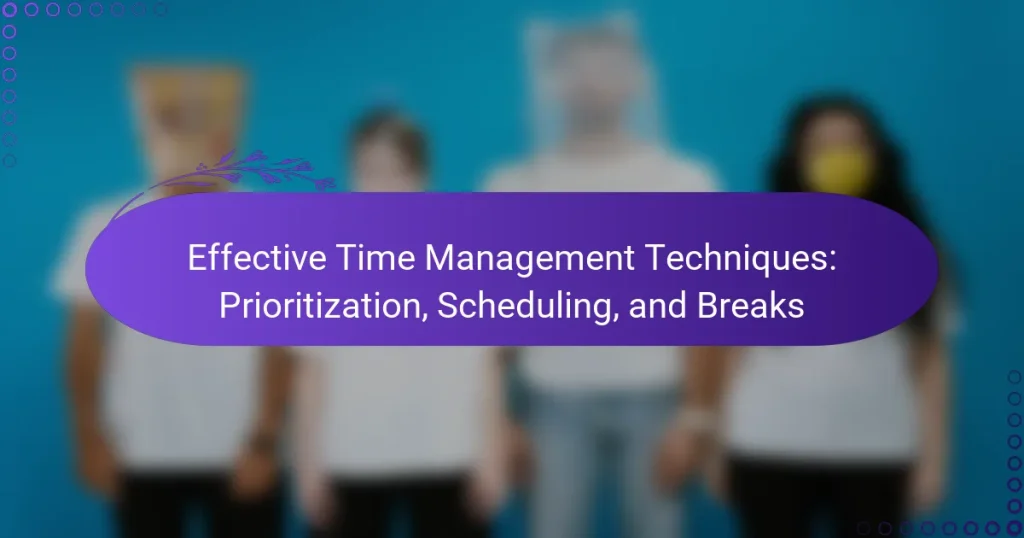Effective time management is essential for maximizing productivity and achieving goals in a fast-paced environment. By employing techniques such as prioritization, scheduling, and taking regular breaks, individuals can enhance their focus, reduce stress, and work more efficiently. These strategies not only help in managing tasks effectively but also promote a healthier work-life balance.

What are effective time management techniques for professionals?
Effective time management techniques for professionals include prioritization, scheduling, and taking breaks. These strategies help individuals maximize productivity, reduce stress, and achieve their goals efficiently.
Prioritization methods
Prioritization involves determining which tasks are most important and need immediate attention. Common methods include the Eisenhower Matrix, which categorizes tasks into four quadrants based on urgency and importance, and the ABCD prioritization method, where tasks are ranked from A (most important) to D (least important).
To effectively prioritize, consider deadlines, the potential impact of each task, and your personal energy levels throughout the day. For example, tackling high-priority tasks during peak energy times can enhance focus and efficiency.
Scheduling strategies
Scheduling involves allocating specific time slots for tasks to ensure they are completed. Techniques such as time blocking, where you dedicate chunks of time to specific activities, can help maintain focus and reduce distractions. Using digital calendars or planners can facilitate this process.
When creating a schedule, be realistic about how long tasks will take and include buffer time for unexpected interruptions. Aim to schedule your most challenging tasks during your most productive hours, typically in the morning for many professionals.
Importance of breaks
Taking breaks is crucial for maintaining productivity and mental clarity. Short breaks, such as the Pomodoro Technique, which suggests working for 25 minutes followed by a 5-minute break, can help prevent burnout and improve focus. Longer breaks, like a lunch hour, are equally important for recharging.
Incorporate regular breaks into your schedule to enhance overall performance. Avoid the common pitfall of working continuously without rest, as this can lead to decreased efficiency and increased fatigue over time.

How can prioritization improve productivity?
Prioritization enhances productivity by helping individuals focus on tasks that yield the most significant results. By identifying what is urgent and important, one can allocate time and resources more effectively, leading to better outcomes and reduced stress.
Eisenhower Matrix
The Eisenhower Matrix is a simple tool that categorizes tasks into four quadrants based on urgency and importance. Tasks are divided into: urgent and important, important but not urgent, urgent but not important, and neither urgent nor important. This method allows you to focus on high-priority tasks while delegating or eliminating less critical ones.
To use the matrix, list your tasks and place them in the appropriate quadrant. For example, a project deadline may fall into the urgent and important category, while a casual meeting could be classified as neither urgent nor important. Regularly reviewing and updating your matrix can keep your priorities aligned with your goals.
ABC prioritization method
The ABC prioritization method involves labeling tasks as A (high priority), B (medium priority), or C (low priority). This straightforward approach helps you quickly identify which tasks require immediate attention and which can wait. A common practice is to tackle all ‘A’ tasks first before moving on to ‘B’ and ‘C’ tasks.
To implement this method, start by writing down your tasks and assigning each a letter based on its importance. For instance, completing a client proposal might be an ‘A’ task, while organizing files could be a ‘C’ task. This system encourages focus on what truly matters, ensuring that your time is spent on impactful activities.

What scheduling techniques enhance time management?
Effective scheduling techniques can significantly improve time management by providing structure and focus. Techniques like time blocking and the Pomodoro Technique help individuals allocate their time wisely, ensuring that important tasks receive adequate attention while minimizing distractions.
Time blocking
Time blocking involves dividing your day into specific blocks dedicated to particular tasks or activities. This method allows you to allocate focused periods for work, meetings, and breaks, reducing the tendency to multitask and enhancing productivity. For example, you might set aside two hours in the morning for deep work on a project, followed by a one-hour block for emails and administrative tasks.
To implement time blocking effectively, start by identifying your most important tasks and estimating how much time each will require. Use a digital calendar or planner to visually map out your blocks, ensuring you include buffer times for transitions. Avoid over-scheduling; aim for 4-6 blocks per day to maintain energy and focus.
Pomodoro Technique
The Pomodoro Technique is a time management method that breaks work into intervals, traditionally 25 minutes in length, separated by short breaks. This approach helps maintain concentration and combat fatigue by providing regular rest periods. After completing four Pomodoros, take a longer break of 15-30 minutes to recharge.
To use the Pomodoro Technique, choose a task and set a timer for 25 minutes. Work on the task until the timer rings, then take a 5-minute break. Repeat this cycle, and after four sessions, take a more extended break. This method is particularly effective for tasks that require sustained attention, as it encourages consistent progress while preventing burnout.

How do breaks contribute to effective time management?
Breaks play a crucial role in effective time management by enhancing focus and productivity. Regularly stepping away from tasks helps to refresh the mind, reduce fatigue, and improve overall performance.
Types of breaks
There are several types of breaks that can be beneficial for time management. Short breaks, often referred to as micro-breaks, typically last a few minutes and can involve stretching or simply stepping away from the workspace. Longer breaks, such as lunch breaks, provide a more substantial rest period, allowing for mental recovery and social interaction.
Another type is the scheduled break, which is planned into the workday, such as the Pomodoro Technique, where individuals work for 25 minutes and then take a 5-minute break. This structured approach can help maintain high levels of concentration and motivation.
Optimal break duration
The optimal duration of breaks can vary depending on the type of work and individual preferences. Short breaks of 5-10 minutes every hour can be effective for maintaining focus and energy levels. For longer breaks, a duration of 30-60 minutes is often recommended, especially during lunch, to allow for adequate mental and physical recovery.
It’s important to listen to your body and adjust break lengths as needed. Overly long breaks can disrupt workflow, while insufficient breaks may lead to burnout. Experimenting with different durations can help find the right balance for individual productivity needs.

What frameworks can help in selecting time management techniques?
Several frameworks can aid in choosing effective time management techniques, focusing on clarity and structure. These frameworks help individuals set clear objectives, prioritize tasks, and allocate time efficiently to enhance productivity.
SMART goals
SMART goals are a widely used framework that ensures objectives are Specific, Measurable, Achievable, Relevant, and Time-bound. This method helps individuals define clear targets, making it easier to track progress and stay motivated.
For example, instead of setting a vague goal like “improve sales,” a SMART goal would be “increase sales by 15% in the next quarter.” This specificity allows for better planning and prioritization of tasks related to achieving that goal.
When setting SMART goals, avoid overly ambitious targets that may lead to frustration. Aim for goals that challenge you but remain realistic, ensuring they align with your overall objectives and available resources.
Time management matrix
The time management matrix, often associated with Stephen Covey, categorizes tasks into four quadrants based on urgency and importance. This framework helps individuals prioritize effectively by distinguishing between what is urgent and what is truly important.
Quadrant I includes urgent and important tasks, while Quadrant II contains important but not urgent tasks. Focusing on Quadrant II can lead to long-term success, as it encourages proactive planning and reduces last-minute stress.
To implement the matrix, list your tasks and categorize them into the four quadrants. Regularly review and adjust your priorities to ensure you are spending time on activities that align with your goals, avoiding the trap of reacting only to urgent matters.

What are the advanced time management tools available?
Advanced time management tools help individuals and teams organize tasks, schedule activities, and optimize productivity. These tools often incorporate features for prioritization, reminders, and collaboration, making them essential for effective time management.
Trello for task management
Trello is a visual task management tool that uses boards, lists, and cards to help users organize their work. Each board can represent a project, while lists can indicate stages of progress, such as “To Do,” “In Progress,” and “Done.” This layout allows for easy tracking of tasks and responsibilities.
To get started with Trello, create a board for your project and add lists for each phase. You can then create cards for individual tasks, assign due dates, and attach relevant files. A common pitfall is overcrowding boards with too many tasks; aim to keep your lists manageable to maintain clarity.
Google Calendar for scheduling
Google Calendar is a powerful scheduling tool that helps users manage their time effectively by allowing them to create events, set reminders, and share calendars with others. It integrates seamlessly with other Google services, making it easy to schedule meetings and deadlines.
When using Google Calendar, color-code events to differentiate between personal and professional commitments. Set reminders for important tasks to avoid last-minute rushes. A useful tip is to block out time for focused work sessions, ensuring you allocate specific periods for deep work without interruptions.


